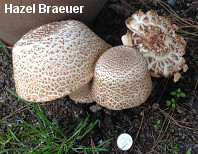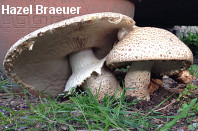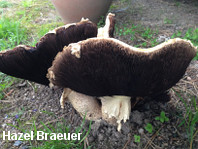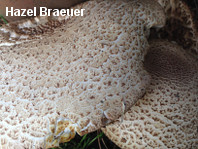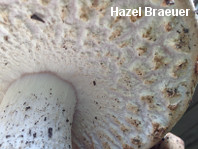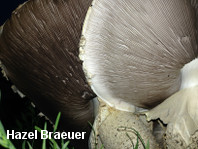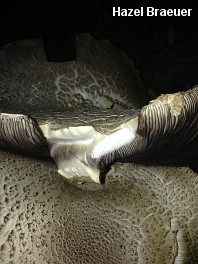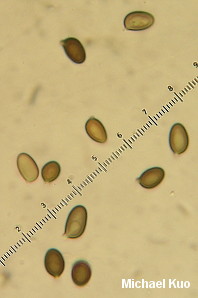| Major Groups > Gilled Mushrooms > Dark-Spored > Agaricus > Agaricus augustus |

|
Agaricus augustus [ Basidiomycota > Agaricales > Agaricaceae > Agaricus . . . ] by Michael Kuo This stunning species, sometimes called "the Prince," is fairly common in California and the Pacific Northwest. It grows under conifers, but is not usually a woodland species; it seems to prefer conifers growing near roads, paths, gardens, parks, and so on. Agaricus augustus is fairly easily identified by its large size, its scaly brown cap, and its strong odor, which is sharp and reminiscent of almonds. A few similar species can be eliminated by adding the Prince's white-then-brown (never pink) gills to the list of distinguishing features, along with its scaly stem. Similar species can be found in other regions, including Agaricus julius in the Rocky Mountains, and Agaricus nanaugustus in the Midwest and eastern United States. Thanks to Hazel Braeuer for collecting, documenting, and preserving a collection of Agaricus augustus for study; her collection is deposited in The Herbarium of Michael Kuo. Description: Ecology: Saprobic; growing scattered or gregariously under conifers, usually along roadsides or paths, or in lawns and gardens; summer and fall, or in winter and spring in warmer climates; West Coast. The illustrated and described collection is from British Columbia. Cap: 10–35 cm; usually blocky and nearly cylindric at first, becoming convex to broadly convex or nearly flat; dry; whitish underneath a dense covering of brown to dark brown, fibrillose scales; bruising yellow, at least near the margin. Gills: Free from the stem; close or nearly crowded; white when young, becoming grayish brown and eventually dark chocolate brown to blackish (without a pink stage); covered when in the button stage with a whitish, cog-wheeled partial veil that features brownish scales. Stem: 10–20 cm long; up to 4 cm thick; more or less equal; often rooting; adorned with a large, skirtlike, whitish ring; whitish and fairly bald above the ring, but below the ring covered with whitish to faintly brownish scales. Flesh: White; unchanging when sliced. Odor and Taste: Odor strong, reminiscent of almonds; taste similar. Chemical Reactions: KOH yellow on cap surface. Spore Print: Dark chocolate brown. Microscopic Features: Spores: 8–10 x 4.5–6 µm; ellipsoid, with a fairly prominent apiculus; smooth; thick-walled; brown in KOH; brown in Melzer's reagent. Cheilocystidia up to about 30 x 10 µm; mostly subglobose to more or less cylindric. Pileipellis a cutis with bundles of uplifted brown, septate elements. REFERENCES: Fries, 1838. (Saccardo, 1887; Smith, 1975; Smith, Smith & Weber, 1979; Arora, 1986; Kerrigan, 1986; McKnight & McKnight, 1987; Phillips, 1991/2005; Lincoff, 1992; Nauta, 2001; Miller & Miller, 2006; Kuo, 2007; Knudsen, Lange & Knutsson, 2008; Trudell & Ammirati, 2009; Desjardin, Wood & Stevens, 2015; Siegel & Schwarz, 2016.) Herb. Kuo 06281405. This site contains no information about the edibility or toxicity of mushrooms. |
© MushroomExpert.Com |
|
Cite this page as: Kuo, M. (2014, July). Agaricus augustus. Retrieved from the MushroomExpert.Com Web site: http://www.mushroomexpert.com/agaricus_augustus.html |
